Print Review of small-circulation publications, distributed by Textfield, Inc., on
1.618, a blog on interesting objects in the field of design and contemporary art by
Журнал Esquire Art Director, Maxim Nikanorov. Project curated by Textfield, Inc.
Publications: Ort (Bücher & Hefte); I Still See Communism Everywhere (Slavs and Tatars); Temporary Storages (The Book Society); A Book About Some People And Time (Myung Feyen); Four Over One (LACMA); Footnote to a Project* (Abraaj Capital Art Prize)
1.618, Abraaj Capital Art Prize, Birgit Vogel, Bücher & Hefte, Distribution, Elmar Bambach, Esquire Russia, Jonathan Maghen, Joo Hwang, Jörg Koopman, Julia Marquardt, LACMA, Martin Fengel, Maxim Nikanorov, mediabus, Myung Feyen, Nikolay Skavinski, Oliver Knight. Rory McGrath, Payam Sharifi, Phil Chang, Print Review, Sharmini Pereira, Slavs and Tatars, Textfield, The Book Society, Vira Biryukova
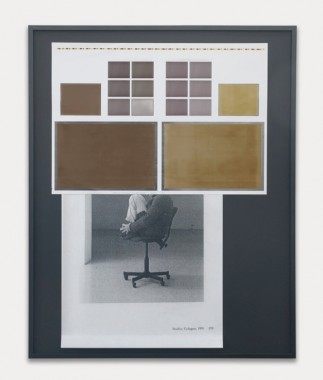
Running Sheet and Artist Portrait; Chromogenic and Offset Prints, 2012
Phil Chang — Studio, Affect
7 July – 11 August 2012
Opening reception: Saturday, 7 July 2012, 7-9pm
Pepin Moore
933 Chung King Rd.
Los Angeles, CA 90012
Pepin Moore is proud to present
Studio, Affect, an exhibition of new works by
Phil Chang, on view from 7 July through 11 August 2012. A reception for the artist will be held Saturday, 7 July from seven to nine in the evening.
As his third and final project that examines the various implications of affect, Phil Chang includes works in Studio, Affect that obliquely address the role of the studio in contemporary culture. Studio, Affect includes various depictions of artist’s studios — photographs of book pages depicting Francis Bacon’s disheveled space, Giacometti in his studio studying his wife, Richter sitting on an office chair — alongside images from catalogs that rely on tropes of the studio. Also included are images Chang has produced which depict his own production. These include photographs of laser prints that have served as studies, and the running sheets (offset prints) from the production of his artist book from 2010. In total, Studio, Affect relies on an array of images presented in an array of formats — chromogenic prints, silver gelatin prints, laser prints, pigment prints, stencil prints, and offset prints — that are hinged within frames. This decision has to do with a desire for “looseness” in presentation that formally and structurally addresses the political and economic implications of the studio.
Art, Chinatown, Exhibitions, Francis Bacon, Jonathan Maghen, Los Angeles, Pepin Moore, Phil Chang, Photography, Studio
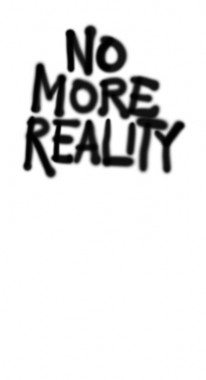
Jonathan Maghen, No More Reality (the poster)
Silkscreen poster/print, 1/0, 19 x 35 inches
Printed on archival Kromekote ultra high-gloss 14 pt cover stock
Edition of 25 + 2 proofs, unnumbered
Published by Textfield
$25.00 ·
The poster/print,
No More Reality (the poster), was produced for the temporary bookshop and exhibition
No More Reality, July 21 — August 25, 2011, which featured the works of Phil Chang, Arthur Ou, Eduardo Sarabia, and Anna Sew Hoy.
The bookshop and exhibition (and poster) title have been appropriated from the Philippe Parreno work, No More Reality (the demonstration), 1991, which is a four-minute video of children demonstrating, and chanting the slogan and title (“No More Reality”). The poster, illustrated by Darius Maghen, is based on a sign held by one of the children in the original Parreno work.
Anna Sew Hoy, Arthur Ou, Darius Maghen, Distribution, Eduardo Sarabia, Jonathan Maghen, Los Angeles, New York, Phil Chang, Philippe Parreno, Sun An, Textfield
Phil Chang
Arthur Ou
Eduardo Sarabia
Anna Sew Hoy
Temporary bookshop and exhibition
July 21 — August 25, 2011
Reception: Thursday, July 21, 6-8pm
Organized by Textfield, Inc.
Creatures of Comfort New York is pleased to present
No More Reality, a temporary bookshop and exhibition organized by Textfield, Inc. The bookshop and exhibition will take place in Creatures of Comfort’s adjacent project space at
205 Mulberry St.
In conjunction with the bookshop, which will feature current and archived titles from Textfield Distribution, there will be an exhibition of work by artists that Jonathan Maghen has collaborated with through Textfield to realize various publishing projects. The exhibition will feature the works of Phil Chang, Arthur Ou, Eduardo Sarabia, and Anna Sew Hoy.
The bookshop and exhibition title have been appropriated from the Philippe Parreno work, No More Reality (the demonstration), 1991, which is a four-minute video of children demonstrating, and chanting the slogan and title (“No More Reality”).
New York Times Tmagazine.
Aki Books, Amir Zaki, Anna Sew Hoy, ART2102, Arthur Ou, Ava Kaufman, Boabooks, C Magazine, Carvalho Bernau, Charlie White, Cheap Art America, Christoph Keller, Condiment, Cornerkiosk Press, Creatures of Comfort, der:die:das:, Distribution, Eduardo Sarabia, Ein Magazin über Orte, Exhibitions, Fellows of Contemporary Art, Fillip, FOCA, FormContent, Four Over One, IFS Ltd., Jade Lai, Jonathan Maghen, Karl Haendel, Keith Bormuth, Kunstverein, LACMA, Laura Bartlett Gallery, Laura Palmer Foundation, Manuel Raeder, Midway Contemporary Art, Mono.Kultur, New York, Nieves, Occasional Papers, OK-RM, Oslo Editions, Paper Monument, Participant Inc, Passenger Books, Phil Chang, Philippe Parreno, Project Projects, Rainoff Books, Regency Arts Press, Schnauzer, Shane Campbell Gallery, Slavs and Tatars, Teknisk Industri AS, Textfield, The Kingsboro Press, Tramnesia, VCFA, Vermont College of Fine Arts, Vier5
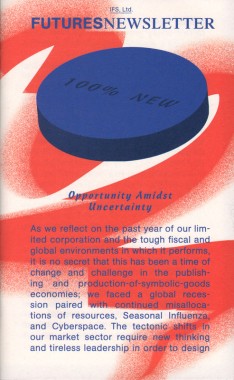
IFS, Ltd. Futures Newsletter, Opportunity Amidst Uncertainty
Softcover, 28 pp., offset 4/4, 110 x 175 mm
Edition of 6000
Published by IFS, Ltd. / Graphic Magazine
free* · out of stock
*free copy with each order
IFS, Ltd. Futures Newsletter is, in non-equal parts: a corporate bulletin, a speculative trading instrument, an experiment in memetic and symbiotic publishing, an internal-external analysis of company performance (B. Critton, H. Gassel, B. Griffiths, Z. Klauck, M. Nguyen), a proposal for an allegorical Escape Act (
S. Dockray), a bid for a series of six activities (
D. Horvitz), an abridged catalogue of semi-fictional gemstones (
L. Francescone), a profile of independent art book distributor (
Textfield, Inc.), and a self-reflexive / -reflective cartoon caption contest (
R. Rozendaal).
Investment Futures Strategy, Ltd. (United States) in partnership with GRAPHIC magazine (Korea) is pleased to introduce Futures, a semi-official newsletter published as a stand-alone supplement to GRAPHIC #17 (”When Design Becomes Attitude”). In lieu of a traditional contribution, IFS, Ltd. has chosen to use the GRAPHIC platform to continue its experiments in trade and publishing.
The Book Trust Prospectus examined new possibilities for funding, trade value, and distribution by attaching a different kind of significance to the object, thus short-circuiting the expected monetary transaction. Production of the Prospectus, however, relied on labor-intensive methods that required hours of input for a relatively small output. With the Futures newsletter, IFS, Ltd. has hybridized the positive aspects of large-scale corporate publishing — economies of scale or large print-runs, distribution of labor, and maximum efficiency — with the dictatorial authorship afforded by self-publishing. This new model maximizes potential as authors and designers while minimizing the opportunity cost of production and distribution.
Within the logic of IFS, Ltd. Futures will also act as a form of currency: readers can use their copy of the newsletter to trade for a copy of the Book Trust Prospectus. These recirculated copies of Futures will then be re-made available as a way to generate revenue for a future, freely distributed, as-yet-undefined project thus continuing the self-sustaining eco-system of publishing and distribution, one in which readers and producers collaborate to generate and circulate content outside of the cost-prohibitive channels of traditional publishing.
Art, Benjamin Critton, Brendan Griffiths, David Horvitz, Design, Distribution, Futures Newsletter, Graphic Magazine, Harry Gassel, IFS Ltd., Interview, Jonathan Maghen, Lauren Francescone, Lim Kyung Yong, Mylinh Nguyen, Na Kim, Nanette Sullano, Phil Chang, Rafael Rozendaal, Sean Dockray, Textfield, The Book Prospectus, Zak Klauck
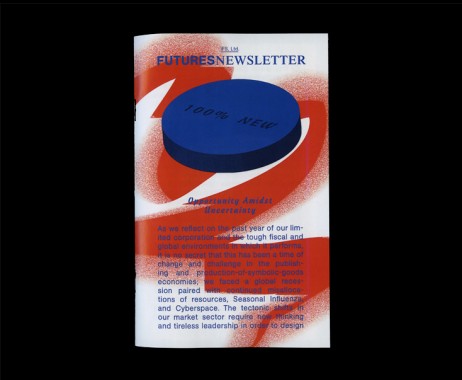
Investment Futures Strategy, Ltd. (United States) in partnership with
GRAPHIC magazine (Korea) is pleased to introduce
Futures, a semi-official newsletter published as a stand-alone supplement to GRAPHIC #17 (”When Design Becomes Attitude”). In lieu of a traditional contribution, IFS, Ltd. has chosen to use the GRAPHIC platform to continue its experiments in trade and publishing.
The Book Trust Prospectus examined new possibilities for funding, trade value, and distribution by attaching a different kind of significance to the object, thus short-circuiting the expected monetary transaction. Production of the Prospectus, however, relied on labor-intensive methods that required hours of input for a relatively small output. With the Futures newsletter, IFS, Ltd. has hybridized the positive aspects of large-scale corporate publishing — economies of scale or large print-runs, distribution of labor, and maximum efficiency — with the dictatorial authorship afforded by self-publishing. This new model maximizes potential as authors and designers while minimizing the opportunity cost of production and distribution.
Within the logic of IFS, Ltd. Futures will also act as a form of currency: readers can use their copy of the newsletter to trade for a copy of the Book Trust Prospectus (see: the Prospectus, left). These recirculated copies of Futures will then be re-made available as a way to generate revenue for a future, freely distributed, as-yet-undefined project thus continuing the self-sustaining eco-system of publishing and distribution, one in which readers and producers collaborate to generate and circulate content outside of the cost-prohibitive channels of traditional publishing.
The IFS, Ltd. Futures Newsletter is, in non-equal parts: a corporate bulletin, a speculative trading instrument, an experiment in memetic and symbiotic publishing, an internal-external analysis of company performance (B. Critton, H. Gassel, B. Griffiths, Z. Klauck, M. Nguyen), a proposal for an allegorical Escape Act (S. Dockray), a bid for a series of six activities (D. Horvitz), an abridged catalogue of semi-fictional gemstones (L. Francescone), a profile of independent art book distributor (Textfield, Inc.), and a self-reflexive / -reflective cartoon caption contest (R. Rozendaal).
Benjamin Critton, Brendan Griffiths, David Horvitz, Design, Futures Newsletter, Graphic Magazine, Harry Gassel, IFS Ltd., Interview, Jonathan Maghen, Lauren Francescone, Lim Kyung Yong, Mylinh Nguyen, Na Kim, Nanette Sullano, Phil Chang, Rafael Rozendaal, Sean Dockray, Textfield, The Book Prospectus, Zak Klauck
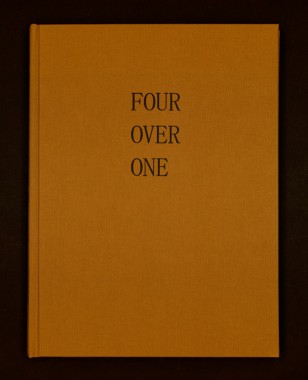
Phil Chang, Four Over One
Hardcover, 64 pp., offset 4/1, 240 x 320 mm
Edition of 500
ISBN 978-087588720-4-9
Published by LACMA
$39.00 ·
In
Four Over One, the Los Angeles based artist
Phil Chang employs the format of an artists book to explore ideas of economy and obsolescence. In collaboration with designer Jonathan Maghen,
Four Over One is structured around Chang’s interest in how new outcomes arise from an antagonism between perceived and actual forms of value. The photographs that appear in the book were created using expired photographic materials exposed by an archival book scanner. Through a sparse display of color, black and white, and half-tone photographs, in conjunction with a restrained typographic treatment,
Four Over One employs an economy of scale in order to consider the roles of abstraction, methods of art production, and modes of distribution in our contemporary culture.
Artforum 500 Words.
Art, Charlotte Cotton, Criticism, Culture, Jonathan Maghen, LACMA, Phil Chang, Photography, RAM, Textfield, Typography, Wallis Annenberg Photography Department
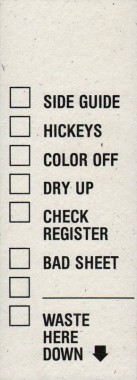
Jonathan Maghen, Waste Bookmark
Bookmark, offset 1/0, 2 x 5.5 inches
Edition of 11 + 2 proofs, unnumbered
Published by Textfield
$2.00 ·
Card used by Pressman to indicate any waste, errors, bad sheets, etc., on a printed job to the Bindery; typically made from the waste sheets of other printed jobs. Re-reused as a bookmark; part of an unfinished book, used to bookmark the pages of a finished book.
Art, Bookmark, Distribution, Jonathan Maghen, Offset, Phil Chang, Press Check, Textfield, Typecraft Wood & Jones, Waste
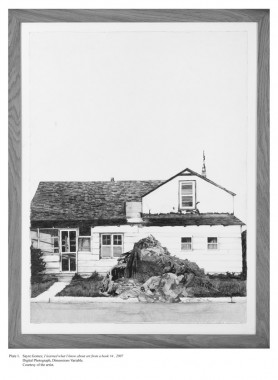
September 17th — October 31st
Reception: Thursday, September 17th, 6:30-8:30pm
Cirrus Gallery
542 S Alameda St
Los Angeles CA 90013
Tuesday through Saturday, 10am-5pm
(213) 680-3473
The Awful Parenthesis is a group exhibition of works by six Los Angeles-based artists. Formed in response to a proposition initiated by Cirrus Gallery, it presents a selection of emerging artists without prior relationship to the space or its history.
Phil Chang
Matt Connors
Sayre Gomez
Nick Kramer
Kim Schoen
Erika Vogt
curated by Aram Moshayedi
The exhibition is organized around a concept of spatial and temporal dislocation developed by Thomas De Quincey in 1823, wherein a disruptive knock at the gate in Shakespeare’s Macbeth is described as “the re-establishment of the goings-on of the world in which we live.” It is in this moment, De Quincey writes, that we are made profoundly aware of “the awful parenthesis” that had rendered the scene “cut off by an immeasurable gulf from the ordinary tide and succession of human affairs.” Brian O’Doherty later used this oft-cited passage as the starting point of his important essay “Context as Content,” published in the pages of Artforum in 1976. For O’Doherty, the activities that take place within the institutional frame of the gallery space undergo a suspension in time and space not unlike the stasis allegorized by De Quincey in the preceding century.
The artworks in The Awful Parenthesis engage with conditions of materiality and conceptual bracketing and attempt to redefine the relationships between a visual medium’s history and its institutional contexts of display. The approaches represented here investigate the material qualities of images and objects as they relate to architectural and historical specificity; they reveal both inward and outward tendencies toward formal and discursive devices of framing. Each artist’s contribution to the exhibition exists within and outside the suspended spaces of viewing, separately renegotiating how space is delineated within both the picture frame and the context in which pictures, as objects, are looked upon.
Aram Moshayedi, Cirrus Gallery, Erika Vogt, Kim Schoen, Matt Connors, Nick Kramer, Phil Chang, Sayre Gomez







